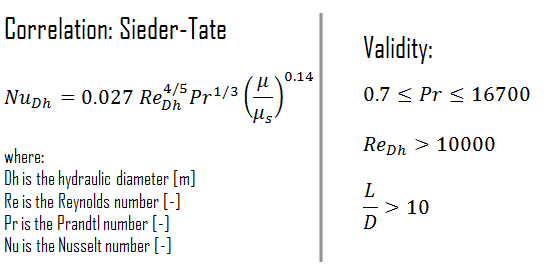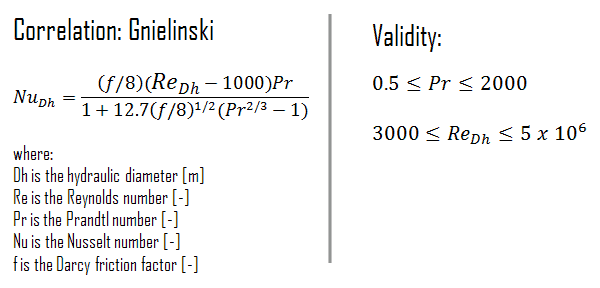Sieder-Tate Equation
The Dittus-Boelter correlation may be used for small to moderate temperature differences, Twall – Tavg, with all properties evaluated at an averaged temperature Tavg.
For flows characterized by large property variations, the corrections (e.g. a viscosity correction factor μ/μwall) must be taken into account, for example, as Sieder and Tate recommend.
When the difference between the surface and the fluid temperatures is large, it may be necessary to account for the variation of viscosity with temperature. Therefore a modified form of Dittus-Boelter equation was proposed by Sieder and Tate (1936).
ss
Gnielinski Equation
Although the Dittus-Boelter and Sieder-Tate equations are easily applied and are certainly satisfactory for the purposes of this article, errors as large as 25% may result from their use. Such errors may be reduced through the use of more recent, but generally more complex, correlations such as the Gnielinski correlation. This equation is valid for tubes over a large Reynolds number range including the transition region.
The Darcy friction factor, f, is a dimensionless quantity used in the Darcy–Weisbach equation, for the description of frictional losses in pipe or duct as well as for open-channel flow. This is also called the Darcy–Weisbach friction factor, resistance coefficient, or simply friction factor.
Rough-walled Tubes
We also note that all these equations pertain to smooth tubes. For turbulent flow in rough tubes, the heat transfer coefficient increases with wall roughness. As the Reynolds number increases, the viscous sublayer becommes thinner and smaller. At very high Reynolds number the viscous sublayer becomes so thin that the surface roughness protrudes into the flow. The frictional losses in this case are produced in the main flow primarily by the protruding roughness elements, and the contribution of the laminar sublayer is negligible.
Special Reference: A Heat Transfer Textbook, John H. Lienhard IV and John H. Lienhard V. Phlogiston Press, 2012.
We hope, this article, Sieder-Tate Equation, helps you. If so, give us a like in the sidebar. Main purpose of this website is to help the public to learn some interesting and important information about thermal engineering.

